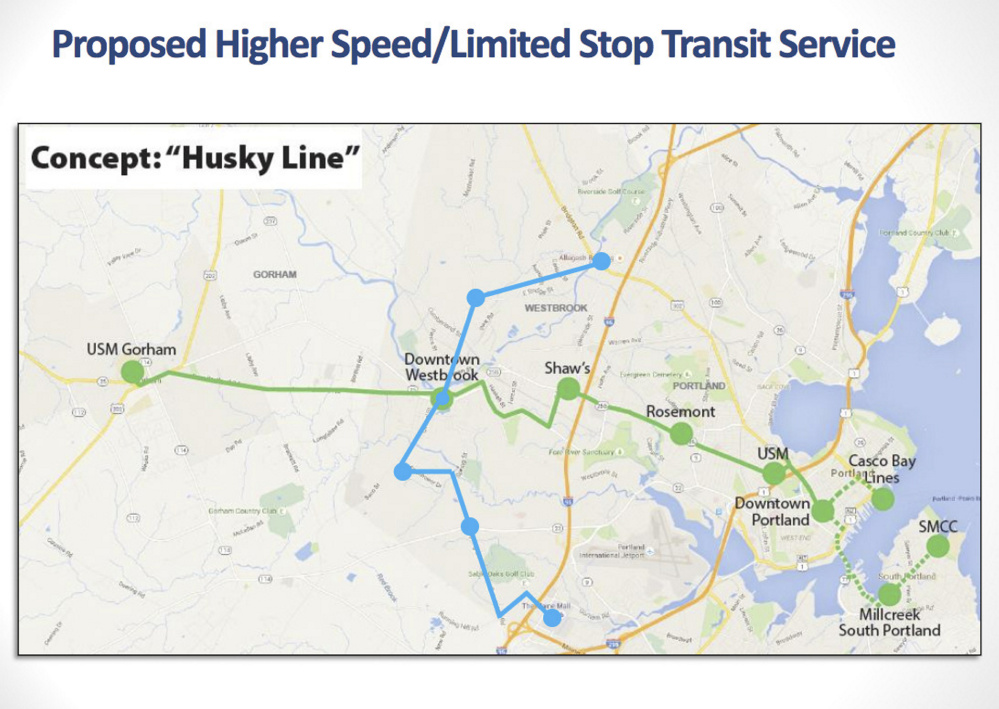Metro is proposing a major expansion for an express service between Portland and Gorham, a new cross-town Westbrook bus line and an unlimited access transit pass program for University of Southern Maine students.
The project is in its early stages, but the linchpin is a USM pass program that could add hundreds of thousands of boardings annually. A partnership with USM could leverage funding from Gorham and Westbrook and money from other sources, such as federal transportation grants.
“The pass program we envision connects the entire transport network to students, and we can use the revenue as a foundation to hook up with some other sources to make significant transportation improvements,” Metro General Manager Greg Jordan said. “The more participants in this, the easier it is going to be for the whole thing to happen.”
A pilot project could last three to five years.
If everything goes as planned, Metro could launch its Gorham-Portland service by 2018.
The proposed expansion follows similar Metro initiatives in the last few years to increase mass transit in the Portland area. Last year, Metro started transporting Portland’s high school students, contributing to its highest ridership in nearly three decades. Last month, Metro launched the Breez express service between Freeport, Yarmouth and Portland, the first public transit connection between the city and its northern suburbs. Online and smartphone tools that help passengers track buses in real time were released in June.
But the proposed expansion would be the most significant to date.
The plan consists of three different components. Metro is proposing a transit pass program for USM students, and possibly faculty and staff, that would give them unlimited access to the transit system. Metro would pair the passes with an express bus service linking the USM campuses in Portland and Gorham, replacing a student shuttle service.
The proposed service, temporarily dubbed the Husky Line, would have limited stops, and take about 30-35 minutes between campuses, 10 minutes slower than the shuttle. The trade-off would be more frequent buses and Sunday service.
Metro estimates the USM program could add between 300,000 and 400,000 one-way trips in its first year, a 25 percent increase to its 2015 ridership. With $1 fares, the maximum cost to USM in the first year would be $400,000, according to Metro projections.
Buster Neel, USM’s interim chief business officer, said university officials were interested in the plan and analyzing if it will work for the school. The university hopes to have an answer one way or another in the next month, he said.
“It would definitely be a real plus for our students if it could work,” Neel said. “We are looking at it, and if we can make it work, we will pursue it.”
Metro is scheduled to present the plan to the Gorham Town Council on Tuesday. Town Manager David Cole said the idea for a transit link with Portland has been discussed before, but not for a few years.
“People are curious and interested in seeing what kind of a plan it would be,” Cole said. Whether public transit is a priority for the town is a different question.
“We certainly have a lot of priorities. Where this would fit in would depend on a lot of factors,” Cole said.
In Westbrook, however, elected officials and residents have been clamoring for more transportation options for years, said Michael Foley, City Council vice president and a Metro board member.
Metro Route 4 serves Westbrook and has some of the highest ridership in the system, but it also has numerous legs and a complicated timetable. The proposed cross-town bus would link the Prides Corner neighborhood on Route 302 through downtown Westbrook to the Maine Mall in South Portland. A direct connection to the mall has been a goal for years, Foley said. To get to the mall from Westbrook now means busing into downtown Portland, then back out to South Portland, an hour-and-a-half-long trip.
“The community has always struggled from a public transport standpoint from getting to the mall. That is something riders have always desired,” Foley said.
The proposed transit route would also serve Spring Street, an area of Westbrook rapidly developing with new housing and commercial projects.
With the increased appeal of urban living, a booming rental housing market, and an interest in walking and biking as alternatives to personal automobiles, Metro’s expansion plan is coming at the right time for the Portland area, Jordan said.
“I think there is a huge demand for transit in the region. That has not been the norm, but attitudes are changing,” he said.
Send questions/comments to the editors.



Comments are no longer available on this story